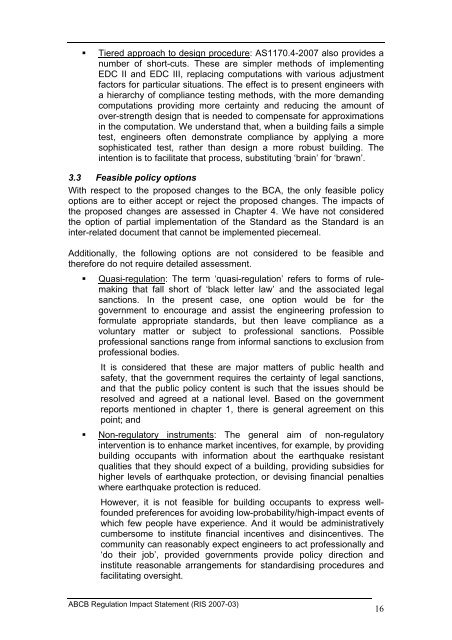PDF | 2 MB - Australian Building Codes Board
PDF | 2 MB - Australian Building Codes Board
PDF | 2 MB - Australian Building Codes Board
You also want an ePaper? Increase the reach of your titles
YUMPU automatically turns print PDFs into web optimized ePapers that Google loves.
• Tiered approach to design procedure: AS1170.4-2007 also provides a<br />
number of short-cuts. These are simpler methods of implementing<br />
EDC II and EDC III, replacing computations with various adjustment<br />
factors for particular situations. The effect is to present engineers with<br />
a hierarchy of compliance testing methods, with the more demanding<br />
computations providing more certainty and reducing the amount of<br />
over-strength design that is needed to compensate for approximations<br />
in the computation. We understand that, when a building fails a simple<br />
test, engineers often demonstrate compliance by applying a more<br />
sophisticated test, rather than design a more robust building. The<br />
intention is to facilitate that process, substituting ‘brain’ for ‘brawn’.<br />
3.3 Feasible policy options<br />
With respect to the proposed changes to the BCA, the only feasible policy<br />
options are to either accept or reject the proposed changes. The impacts of<br />
the proposed changes are assessed in Chapter 4. We have not considered<br />
the option of partial implementation of the Standard as the Standard is an<br />
inter-related document that cannot be implemented piecemeal.<br />
Additionally, the following options are not considered to be feasible and<br />
therefore do not require detailed assessment.<br />
• Quasi-regulation: The term ‘quasi-regulation’ refers to forms of rulemaking<br />
that fall short of ‘black letter law’ and the associated legal<br />
sanctions. In the present case, one option would be for the<br />
government to encourage and assist the engineering profession to<br />
formulate appropriate standards, but then leave compliance as a<br />
voluntary matter or subject to professional sanctions. Possible<br />
professional sanctions range from informal sanctions to exclusion from<br />
professional bodies.<br />
It is considered that these are major matters of public health and<br />
safety, that the government requires the certainty of legal sanctions,<br />
and that the public policy content is such that the issues should be<br />
resolved and agreed at a national level. Based on the government<br />
reports mentioned in chapter 1, there is general agreement on this<br />
point; and<br />
• Non-regulatory instruments: The general aim of non-regulatory<br />
intervention is to enhance market incentives, for example, by providing<br />
building occupants with information about the earthquake resistant<br />
qualities that they should expect of a building, providing subsidies for<br />
higher levels of earthquake protection, or devising financial penalties<br />
where earthquake protection is reduced.<br />
However, it is not feasible for building occupants to express wellfounded<br />
preferences for avoiding low-probability/high-impact events of<br />
which few people have experience. And it would be administratively<br />
cumbersome to institute financial incentives and disincentives. The<br />
community can reasonably expect engineers to act professionally and<br />
‘do their job’, provided governments provide policy direction and<br />
institute reasonable arrangements for standardising procedures and<br />
facilitating oversight.<br />
ABCB Regulation Impact Statement (RIS 2007-03)<br />
16
















